Newbie to Numero Uno, Nirma’s story of emerging as the successful underdog
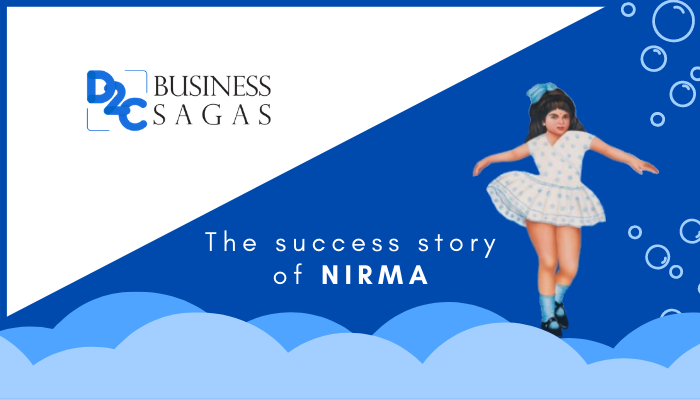
‘Hema, Rekha, Jaya aur Suhmaa, sabki pasand Nirma’ was on everyone’s lips after the detergent powder brand Nirma launched this ad jingle in the 1970s. Nirma became a name known to every household of India for low-cost, quality washing powder at a time when the Indian consumers were making the transition from washing soaps to surf. At a time when Hindustan Lever Limited (HLL) was the only brand offering detergent powder, that too, at a high price, Nirma’s entry changed the whole market scene. By 1985, just after almost 15 years of its entry into the market, it had become one of the most popular detergent brands in some parts of India. By 1999, it had already launched a whole range of soaps and personal care products apart from the washing powder Nirma.
The birth of an idea
The success story of Nirma began with a vision of its founder. Nirma as a contrivance for cleaning clothes was the brainchild of Karsanbhai Patel, a chemist at the Department of Mining and Geology under the Government of Gujarat. The department manufactured phosphate-free synthetic detergent powder which Mr. Patel further started manufacturing in his house. After packaging the detergent neatly, he started handing out packets to people on his way to the office. After it gained popularity due to its low price of INR 3.5 per kg against the surf sold at INR 13 per kg in the commercial market, Mr. Patel started manufacturing it on a large scale. Washing powder Nirma derives its name from his daughter, Nirupama.
The importance of details
The success story of Nirma had many ingredients apart from the price tag on the product. When Mr. Patel started Nirma, he knew his target audience well. The product did not just hold a low price but looked simple enough to attract the low-income group of consumers. The packaging was neat. The packet was made of a transparent plastic sheet with just the name of the girl's mascot on top of it. Sometimes it also appeared to have been just rolled and stapled into packets. In contrast, the surf from HLL came in a sophisticated-looking blue box, adorned with elaborate graphics. The difference between an MNC and a homegrown product could thus efficiently reach the masses.
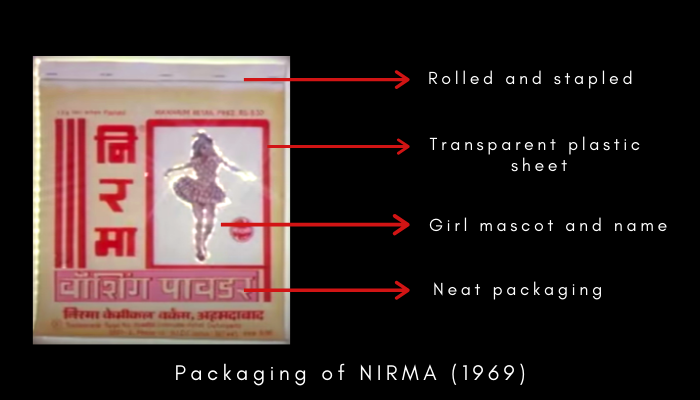
The company's mission to provide, "Better Products, Better Value, Better Living" was also the message delivered through its cost-reduction strategy. When it entered the market, it did not use any whitening agent nor did it use any perfuming agent in the detergent. It helped the price of washing powder Nirma to remain low. Not only that, but it also paid close attention while deciding on its distribution reach and market penetration efforts. It first established a network of 400 distributors aimed at reaching the masses, especially the rural areas where low-income consumers would buy Nirma products easily over other alternatives due to the massive price difference. To build confidence in those going for the newcomer, Nirma also came with a money-back guarantee at all times. All these factors contributed massively to the success story of Nirma.
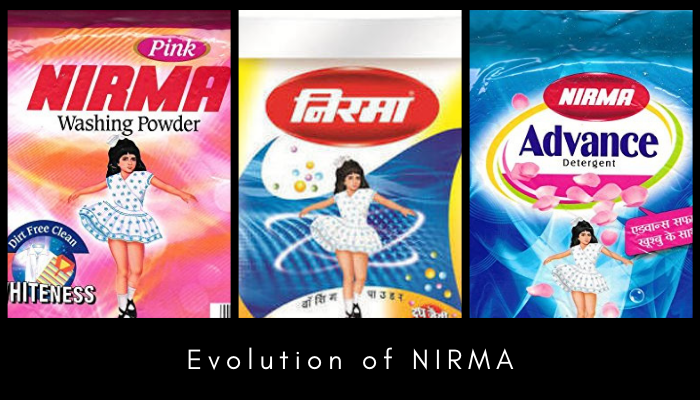
The power of good advertising
Nirma’s advertising strategy came as nothing less than a revolution. In the 1970s, when Nirma entered the market, the biggest challenge that it faced was to make its targeted audience aware of the existence of washing powder Nirma, the low cost, quality detergent competing with HLL’s surf. This was exacerbated because the few means of advertising available were only radio, newspaper and magazines and some few hours of television. Mr. Patel, taking a chance on the increasing scope of television commercials, chose TV advertising for Nirma. And the rest is history.
A new perspective
Karsanbhai Patel collaborated with Purnima Advertising Agency to create the famous ad jingle ‘Sabki pasand Nirma’, which debuted on the radio and was later released as a TVC. The ad portrayed housewives washing clothes playfully, and happily. It changed the way how the activity of washing clothes was usually seen. In the ads by Nirma, unlike other brands, the activity was shown as something the housewives could enjoy. ‘Kam keemat’ and ‘Jhaag Dher Saara’ were the major focus of such ads, trying to press on the low-cost factor coupled with quality that every housewife would love to go for.
The need to revamp
The success story of Nirma has a very important feature. As Nirma’s popularity and sales grew in numbers, a new India was also emerging. Nirma had earlier targeted the low-income consumers and had been able to win their attention. But now, the lower-middle-income group that had grown loyal to Nirma, was transitioning into the upper-middle class. Nirma’s advertising needed to be revamped in accordance with the changing times. Kudos to Mr. Patel, the realization was on time.
Soon, Nirma’s ads started featuring some famous Bollywood names such as Sonali Bendre promoting Nirma’s beauty soap. The famous ad song ‘Soundarya Sabun Nirma’ was sung by Hariharan and Kavita Krishnamurthy, whose voice was well-known and loved in Indian households at the time. Nirma partnered with Kailash Surendranath, a pioneer in the TVC industry at the time, to creatively ideate Nirma’s ads with the ongoing trends.
The success story of Nirma served as proof of the power of advertising. Nirma responded to the ongoing changes not only through its product but also through its advertising. With the growth of television viewing in India, daily soaps became a favorite of Indian women. Nirma tapped this sphere and included it in its advertising efforts. Hema, Rekha, Jaya, and Sushma were made over like characters in a daily soap, quarreling over food and resorting to washing clothes with washing powder Nirma.
Soaring through competition
The success story of Nirma like any story included some huge challenges. One of them is competition. When Nirma entered the market in 1969, surf by Hindustan Lever Limited was already a dominator. It was the first washing powder in India, launched in 1959. So, the journey for Nirma wasn’t going to be easy. At first, HLL, typical of major players in the market, did not feel intimidated by Nirma, as the products by Nirma were for the bottom-most segment of the pyramid while HLL’s products were for the upper end. Eventually, as Nirma became popular, HLL realized that there was a huge market amongst the middle and lower-income groups that could shake the position of the conglomerate, if not captured.
The brand war was in full flow when Nirma grew to capture at least 38% of the market share in the detergents market while HLL remained at 31% during the 1980s. Other competitors such as Ghari from RSPL India had just been launched and were far from becoming major players. With alarm bells tolling, HLL started to direct its advertising efforts to capture the low-income market with its surf. It understood that the price of Surf could not be reduced, but it could be projected as the smarter option. ‘Lalitaji’, the smart housewife, played by Kavita Chaudhary, a renowned face from the soap ‘Udaan’ featured in Surf’s ads, professing the importance of quality over price. The popularity of these ads relieved HLL, although Nirma wasn’t just watching the show.
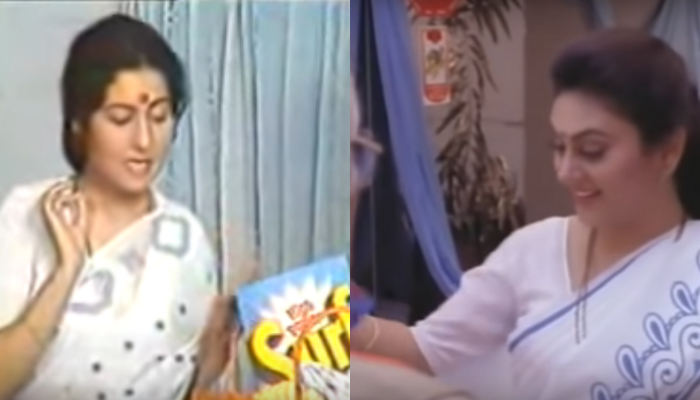
Soon, Nirma released its ad, featuring ‘Deepikaji’, another progressive woman, played by Dipika Chikhlia, famous at the time for her role as Sita in Doordarshan’s Ramayana, choosing Nirma over other expensive brands. The question that the ad posed to the consumers was why should one go for an expensive brand if the low-priced soap could offer better quality. The success story of Nirma is marked by many such instances, and Nirma though it all, did not back down.
Taking a chance on Femvertising
Nirma’s ads had always been led by women. When it came on the market, it advertised washing powder Nirma as a product for housewives. Later though, it also came up with a variety of other ads, many of them devoid of housewives as such, but still portraying women taking the lead. One had Russian ballet dancers, dancing underwater to the tune of the Nirma ad jingle while another had a young woman dancer, practicing her sport. With the roles of women changing over time and more and more of them taking up roles beyond their own homes, Nirma’s ads also delivered the message of gender equality. One of such ads showed the four women, pushing a stuck ambulance out of a puddle, while another showed Hrithik Roshan, one of the stars of Bollywood, doing laundry, to show that men and women, both, can share roles rather than restricting themselves to only some.

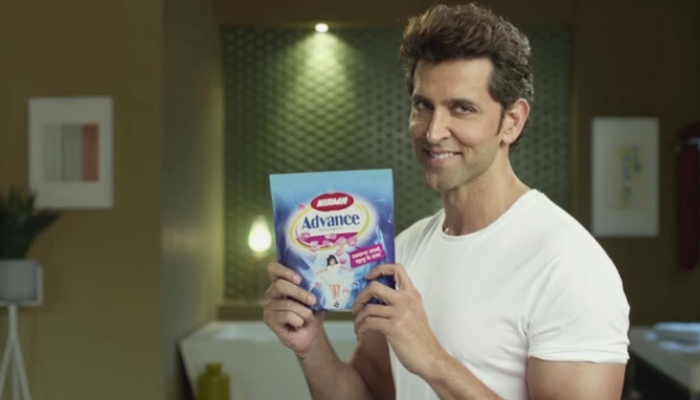
S.T.I.N.G
HLL’s brainchild S.T.I.N.G was short for ‘Strategy to Inhibit Nirma Growth’. It was created in the aftermath of the 1970s and the first half of 1980s to strategize towards inhibiting Nirma’s growth in the detergents and soap market. HLL understood that Surf or any other existing product could not be made of use to do so, there was the risk of losing equity. In 1988, a year after the launch of Ghari, HLL launched Wheel, its low-priced detergent to combat the washing powder Nirma. For the first time, through Wheel, HLL resorted to third-party production with flexible pricing of the product with features very similar to Nirma, i.e. extra lather and safe for hands, at a low price. It also launched ‘Sunlight’, a white detergent powder with the same price as washing powder Nirma, for eastern and southern states of India where Nirma did not have a huge consumer base. Subsequently, more competitors joined the market, such as Ariel and Tide from the house of P&G.
The road ahead
Beginning with one product, one-man model, Nirma has touched unprecedented heights. The success story of Nirma is not a smooth sail, but definitely an inspiring one. Players in the market have given a tough competition to Nirma, shaking its position but it is still in the market. It subsequently has launched toilet soaps for the premium segment and now has a range of products for lower, middle, and higher-income groups. In recent years, it has also entered the cement industry with NIRMAX, further acquiring Lafarge India Cement Assets and Emami, another big cement company. Today, Nirma has over 25000 employees and banks a turnover of more than INR 20,500 crores.
The success story of Nirma is full of lessons that can change the fate of businesses. Prioritizing consumer preferences, providing quality products at lower prices, and most importantly, connecting to sentiments of the targeted audience are lessons that can help businesses succeed even in the face of competitors and other challenges. All in all, Nirma is here to stay and the future does seem bright for this underdog rising from one among the many small towns of India. And all this while, we can take notes from the success story of Nirma, the underdog rising to the top.
This article was co-authored by Saurabh Bhandari, in response to D2C Business Sagas. If you'd like to submit your story, click here.
o get more insights on how the business world buzzes, read:
- The secret behind the booming growth of Made-in-India D2C company, Mamaearth
- The rise and rise of Zomato - A case study
- Covid-19 impact: Can the world of beauty and cosmetics prove resilient?
- How digital marketing is disrupting the marketing space -By Shaurya Vaid from Shiv Nadar University
- Changing facets of CSR in the new normal era: The community service by companies
Login to continue reading
And access exclusive content, personalized recommendations, and career-boosting opportunities.
Blogs you need to hog!

What Innovation Does For Efficiency and Competitiveness in a Corporate Sector?

Online to Offline Commerce- Everything one needs to know

How Do You Work Around Branding Guidelines To Be Guidelines And Not Limitations? | Alekhya, Brand Manager- Vivel, ITC | Dove, Unilever













Comments
Add comment